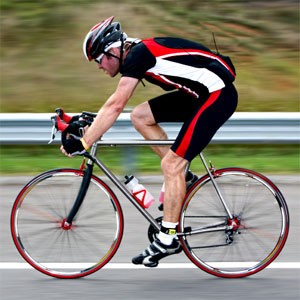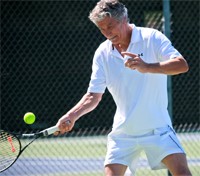|
|
Training For Cycling
Author:
Joe Friel
Original Posting:
12/12/2008 06:21 AM
Last Revision: 07/23/2022 10:25 AM
 Are you looking for some training advice to improve your cycling performance? Joe Friel has summarized 10 tips, originally published in VeloNews under the title "The Ten Commandments of Training". I have edited his original article slightly and reproduced it below. --Editor. Are you looking for some training advice to improve your cycling performance? Joe Friel has summarized 10 tips, originally published in VeloNews under the title "The Ten Commandments of Training". I have edited his original article slightly and reproduced it below. --Editor.
Here is my training philosophy: An athlete should do the least amount of properly timed, specific training that brings continual improvement.
The idea of limiting training is a scary thought for some athletes. Many cyclists have become so accustomed to overtraining that this strategy seems normal to them. The chronically overtrained athlete is not getting any better but still can't convince himself or herself to change.
My basic philosophy is simply "use your training time wisely." For those of us with full-time jobs, spouses, children, a home to maintain, and other responsibilities, using training time wisely is more than a philosophy; it's a necessity.
What this means is that there are times when it's right to do higher-volume training, but not necessarily the highest possible. This is usually in the Base (general preparation) period of training. There are also times when high volume is not wise, but faster, more race-specific training is right. These are the Build and Peak (specific preparation) periods.
While it seems so simple, there are many cyclists who can't seem to get it right. They put in lots of miles when they should be trying to get faster. And when they should be building a base of general fitness, they're going fast—usually in group hammer sessions.
So what do you use to gauge your progress? Or, how tired you are? Or, how fast you are? Once you figure out that fatigue gets in the way of getting faster and you make the necessary changes, you'll be flying.
To help you better understand this training philosophy I have broken it down into the "Ten Commandments of Training." By incorporating each of these guidelines into your thinking and training, you'll be following this philosophy and getting a better return on your time invested. Your results will also improve regardless of your age or experience.
1. Train Moderately
Your body has limits when it comes to endurance, speed and strength. Muscles will only contract forcefully a certain number of times before they refuse to pull hard again. The biggest mistake of most athletes is to overtrain on the easy days, so when it comes time for a hard training day, they can't go hard enough.
By progressing carefully, especially with intensity, you'll gradually get stronger and there will be time and energy for other pursuits in life. An athlete who enjoys training will get more benefits from it than one who is always on the edge of overtraining.
2. Train Consistently
The human body thrives on routine, and regular activity brings positive change. This does not mean do the same workout every day, week after week. Variety also promotes growth. This is not to say that you shouldn't do hard workouts or that it isn't necessary to push the limits on occasion and experience fatigue as a result.
It's obvious that if coming close to your riding potential is your goal, you must often face and conquer training challenges. Training consistently, not extremely, is the route to the highest possible fitness and your ultimate racing performances. The key to consistency is incorporating moderation and rest into the overall training routine.
3. Get Adequate Rest
During rest, the body adapts to the stresses of training and grows stronger. Without rest, there's simply no improvement. As the stress of training increases, so does the need for rest. When we sleep, our body releases human growth hormone, and it mends and grows stronger.
If our time spent snoozing is shortened, it takes us longer to recover and our consistency in training suffers. Damaged cells take longer to heal, raising the risk of injury and illness. If the training workload remains high despite decreased sleep time, overtraining becomes a real threat. Burnout is lurking just around the corner.
4. Train With a Plan
This is fundamental to improvement in almost any endeavor of life, yet few self-trained athletes do it. Realize that all plans can be changed. Yours will not be chiseled into stone. It takes some flexibility to cope with the many factors that will get in your way. These may include a bad cold, overtime at work, unexpected travel, or a visit from family or friends.
I have yet to coach an athlete who didn't have something interfere with the plan. Expect it, but don't be upset. Roll with the punches and change the plan to fit the new situation.
5. Train With Groups Infrequently
There's a real advantage to working out with others—sometimes. For the base-building period, find a group that rides at a comfortable pace. During the intensity-building period, ride with a group that will challenge you to ride fast, just as when racing.
Smart and structured group rides are hard to find. You may need to create your own. Stay away from big packs that take over the road and are unsafe. You want to get faster, not get killed. Use groups when they can help you. Otherwise, avoid them.
6. Plan to Peak
Your season plan should bring you to your peak for the most important events. I call these "A" races. The "B" races are important, too, but you will not taper and peak for these, just rest for three to four days before. "C" races are tune-ups to get you ready for the A and B races. A smart rider will use these low-priority races for experience, or to practice pacing, or as a time trial to gauge fitness. If all races are A-level priority, don't expect much in the way of results.
7. Improve Weaknesses
What type of training do riders with great endurance, but not much speed, do the most? You guessed it, endurance work. What do good climbers like to do? Not surprisingly, they like to train in the hills. Most cyclists spend too much time working on what they already do well. What's your weakest area? Ask your training partners if you don't know. I'll bet they do. Then spend more time on that area.
8. Trust Your Training
Few of us trust our training when it comes time to race. There's a great fear as the big race approaches that we haven't done enough, so we train right up to race day. I've seen people the day before an important race go out for a long ride or compete in a hard race because they think it will help.
It takes 10 to 21 days of reduced workload for the human body to be fully ready to race, depending on how long and hard the training has been. Cut back before the big races, and you'll do better. Trust me.
9. Listen to Your Body
In the early 1990s, I attended a talk by the former head of the East German Sports Institute. He described how every morning each athlete met with a group of experts—an event coach, a physiologist, a doctor or nurse, and a sports psychologist, for example.
The group checked the athlete's readiness to train that day and made adjustments as necessary to the schedule. The athlete trained only to the level he or she could tolerate that day. Nothing more. If you listen to what the body is saying, you'll train smarter and get faster. Cyclists who train intelligently always beat athletes who train hard.
10. Commit to Goals
After you set your goals, take a look at them and determine how they relate to your lifestyle and training. Determine whether change is needed. Eat nutritious food to not only fuel the body for training, but also to help speed recovery, replenish depleted energy and nutrient stores, and provide the building blocks for a stronger body.
Keep a training log. Record workout details, perceptions of effort, stress signals, race results and analyses, signs of increasing or decreasing fitness, equipment changes, and anything else that describes your daily experience. Most athletes also find that keeping a log provides them with a sharper training focus and more rapid growth toward their goals.
EDITORIAL COMMENTS
I think there is a lot of wisdom in the advice that Joe Friel has presented above. Some competitive athletes believe that pushing their bodies as hard as they can during a workout is necessary to reach the next performance level. While this may help build psychological strength, it's not always the best strategy for training. The key is to train at an intensity level that stimulates your cardiovascular system, but not sustain that intensity for so long that your musculoskeletal system is compromised.
Thus, the concept of "interval" training applies to cycling as readily as it does to running.....ie., shorter bursts of high-intensity effort. Then, make sure you recover properly: Ingest good protein and carbohydrate within 30-45 minutes after the end of each session, and rest.
FOR MORE INFORMATION
Readers may also be interested in these reviews:
EXPERT HEALTH and FITNESS COACHING Stan Reents, PharmD, is available to speak on a variety of exercise-related topics. (Here is a downloadable recording of one of his Health Talks.) He also provides a one-on-one Health Coaching Service. Contact him through the Contact Us page. ABOUT THE AUTHOR 
Stan Reents, PharmD, is a former healthcare professional. He is a member of the American College of Lifestyle Medicine (ACLM) and a member of the American College of Sports Medicine (ACSM). In the past, he has been certified as a Health Fitness Specialist by ACSM, as a Certified Health Coach by ACE, as a Personal Trainer by ACE, and as a tennis coach by USTA. He is the author of Sport and Exercise Pharmacology (published by Human Kinetics) and has written for Runner's World magazine, Senior Softball USA, Training and Conditioning and other fitness publications.
Browse By Topic:
aerobic exercise, bicycle seats, bicycles, triathlon
Copyright ©2025 AthleteInMe,
LLC. All rights reserved.
|
|